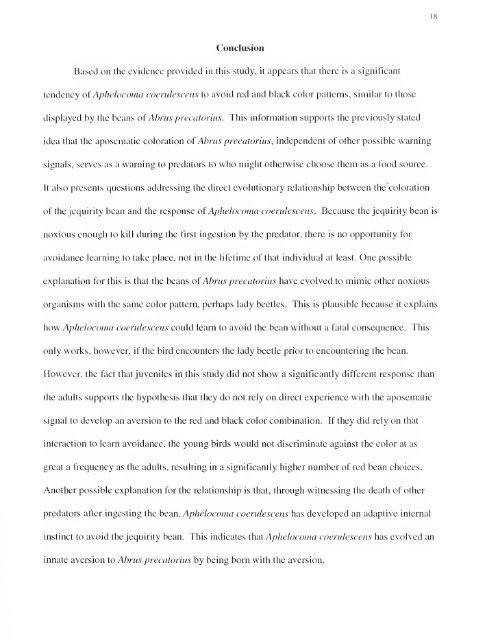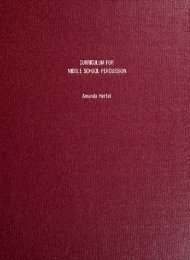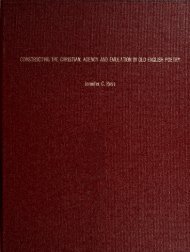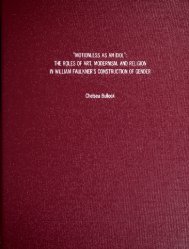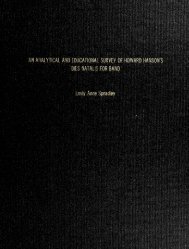The Effect of Aposematic Coloration on the Food Preference of ...
The Effect of Aposematic Coloration on the Food Preference of ...
The Effect of Aposematic Coloration on the Food Preference of ...
- No tags were found...
Create successful ePaper yourself
Turn your PDF publications into a flip-book with our unique Google optimized e-Paper software.
IXC<strong>on</strong>clusi<strong>on</strong>Based <strong>on</strong> <strong>the</strong> evidence provided in this study, itappears that <strong>the</strong>re is a significanttendency <str<strong>on</strong>g>of</str<strong>on</strong>g> Aphelocoma coerulescens to avoid red and black color patterns, similar to thosedisplayed by <strong>the</strong> beans <str<strong>on</strong>g>of</str<strong>on</strong>g> Abrus precatorius.This informati<strong>on</strong> supports <strong>the</strong> previously statedidea that <strong>the</strong> aposematic colorati<strong>on</strong> <str<strong>on</strong>g>of</str<strong>on</strong>g> Abrus precatorius, independent <str<strong>on</strong>g>of</str<strong>on</strong>g> o<strong>the</strong>r possible warningsignals, serves as a warning to predators to who might o<strong>the</strong>rwise choose <strong>the</strong>m as a food source.It also presents questi<strong>on</strong>s addressing <strong>the</strong> direct evoluti<strong>on</strong>ary relati<strong>on</strong>ship between <strong>the</strong> colorati<strong>on</strong><str<strong>on</strong>g>of</str<strong>on</strong>g> <strong>the</strong> jequirity bean and <strong>the</strong> resp<strong>on</strong>se <str<strong>on</strong>g>of</str<strong>on</strong>g> Aphelocoma coerulescens.Because <strong>the</strong> jequirity bean isnoxious enough to kill during <strong>the</strong> first ingesti<strong>on</strong> by <strong>the</strong> predator, <strong>the</strong>re is no opportunity foravoidance learning to take place, not in <strong>the</strong> lifetime <str<strong>on</strong>g>of</str<strong>on</strong>g> that individual at least. One possibleexplanati<strong>on</strong> for this is that <strong>the</strong> beans <str<strong>on</strong>g>of</str<strong>on</strong>g> Abrus precatorius have evolved to mimic o<strong>the</strong>r noxiousorganisms with <strong>the</strong> same color pattern, perhaps lady beetles. This is plausible because it explainshow Aphelocoma coerulescens could learn to avoid <strong>the</strong> bean without a fatal c<strong>on</strong>sequence.This<strong>on</strong>ly works, however, if <strong>the</strong> bird encounters <strong>the</strong> lady beetle prior to encountering <strong>the</strong> bean.However, <strong>the</strong> fact that juveniles in this study did not show a significantly different resp<strong>on</strong>se than<strong>the</strong> adults supports <strong>the</strong> hypo<strong>the</strong>sis that <strong>the</strong>y do not rely <strong>on</strong> direct experience with <strong>the</strong> aposematicsignal to develop an aversi<strong>on</strong> to <strong>the</strong> red and black color combinati<strong>on</strong>.If <strong>the</strong>y did rely <strong>on</strong> thatinteracti<strong>on</strong> to learn avoidance, <strong>the</strong> young birds would not discriminate against <strong>the</strong> color at asgreat a frequency as <strong>the</strong> adults, resulting in a significantly higher number <str<strong>on</strong>g>of</str<strong>on</strong>g> red bean choices.Ano<strong>the</strong>r possible explanati<strong>on</strong> for <strong>the</strong> relati<strong>on</strong>ship is that, through witnessing <strong>the</strong> death <str<strong>on</strong>g>of</str<strong>on</strong>g> o<strong>the</strong>rpredators after ingesting <strong>the</strong> bean, Aphelocoma coerulescens has developed an adaptive internalinstinct to avoid <strong>the</strong> jequirity bean.This indicates that Aphelocoma coerulescens has evolved aninnate aversi<strong>on</strong> to Abrus precatorius by being born with <strong>the</strong> aversi<strong>on</strong>.


